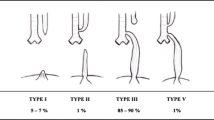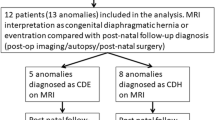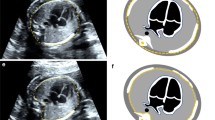Abstract
Background
Tracheal atresia causes some secondary changes (dilated trachea, flattened/inverted diaphragm, hyperintense and hyperinflated lungs). They can be reduced if a high airway fistula is present.
Objective
This study evaluated fetal MR images of tracheal atresia and the secondary changes, focusing on the presence of a fistula.
Materials and methods
We assessed fetal MR images of tracheal atresia without fistula (n=4, median 26 weeks), tracheal atresia with fistula (n=4, median 33 weeks) and controls (n=30, median 32 weeks). We evaluated airway obstruction using true-positive rate in tracheal atresia and false-positive rate in controls indicating they are likely normal variants. Tracheal diameter, craniocaudal-anteroposterior ratio of the right hemidiaphragm, lung-to-liver signal intensity ratio, and cardiothoracic ratio were compared among the three groups using the Kruskal-Wallis test followed by pairwise comparison using the Mann-Whitney U test.
Results
True-positive rate was 100% in tracheal atresia, while false-positive rate was 20% in controls. The Kruskal-Wallis test showed differences among groups in craniocaudal-anteroposterior ratio and cardiothoracic ratio (P<0.001) but not in tracheal diameter (P=0.256) or lung-to-liver signal intensity ratio (P=0.082). The pairwise comparison in craniocaudal-anteroposterior ratio and cardiothoracic ratio showed differences between controls and tracheal atresia without fistula (P<0.01) and with fistula (P<0.05).
Conclusion
Fetal MRI is useful for the diagnosis of tracheal atresia, and detection of airway obstruction is essential. Lower craniocaudal-anteroposterior ratio and cardiothoracic ratio might be reliable measures even if a fistula is present.










Similar content being viewed by others
References
Woodward PJ (2016) Chest. In: Woodward PJ, Kennedy A, Sohaey R (eds) Diagnostic imaging: obstetrics, 3rd edn. Amirsys, Salt Lake City, pp 346–347
Shum DJ, Clifton MS, Coakley FV et al (2007) Prenatal tracheal obstruction due to double aortic arch: a potential mimic of congenital high airway obstruction syndrome. AJR Am J Roentgenol 188:W82–W85
Kuwashiwa S, Kitajima K, Kaji Y et al (2008) MR imaging appearance of laryngeal atresia (congenital high airway obstruction syndrome): unique course in a fetus. Pediatr Radiol 38:344–347
Furukawa R, Aihara T, Tazuke Y et al (2012) Congenital high airway obstruction syndrome without tracheoesophageal fistula and with in utero decrease in relative lung size. Pediatr Radiol 42:1510–1513
Kanamori Y, Tahara K, Ohno M et al (2020) Congenital high airway obstruction syndrome complicated with foregut malformation and high airway fistula to the alimentary tract – a case series with four distinct types. Case Rep Perinat Med 9:20190064
Courtier J, Poder L, Wang ZJ et al (2010) Fetal tracheolaryngeal airway obstruction: prenatal evaluation by sonography and MRI. Pediatr Radiol 44:1800–1805
Guimaraes CV, Linam LE, Kline-Fath BM et al (2009) Prenatal MRI findings of fetuses with congenital high airway obstruction sequence. Korean J Radiol 10:129–134
Wailoo MP, Emery JL (1982) Normal growth and development of the trachea. Thorax 37:584–587
Kalache KD, Franz M, Chaoui R et al (1999) Ultrasound measurements of the diameter of the fetal trachea, larynx and pharynx throughout gestation applicability to prenatal diagnosis of obstructive anomalies of the upper respiratory-digestive tract. Prenat Diagn 19:211–218
Richards DS, Farah LA (1994) Sonographic visualization of the fetal upper airway. Ultrasound Obstet Gynecol 4:21–23
Yamato M, Iwazaki T, Takeuchi K et al (2018) The fetal lung-to-liver signal intensity ratio on magnetic resonance imaging as a predictor of outcomes from isolated congenital diaphragmatic hernia. Pediatr Surg Int 34:161–168
Kuwashima S, Nishimura G, Iimura F et al (2001) Low-intensity fetal lungs on MRI may suggest the diagnosis of pulmonary hypoplasia. Pediatr Radiol 31:669–672
Oka Y, Rahman M, Sasakura C et al (2014) Prenatal diagnosis of fetal respiratory function: evaluation of fetal lung maturity using lung-to-liver signal intensity ratio at magnetic resonance imaging. Prenat Diagn 34:1289–1294
Mong A, Johnson AM, Kramer SS et al (2008) Congenital high airway obstruction syndrome: MR/US findings, effect on management, and outcome. Pediatr Radiol 38:1171–1179
Acknowledgments
This article was supported by a grant from the National Center for Child Health and Development, Japan, 2019-19. We thank Hiroshi Nagamatsu, principal technologist; Rumi Imai, Chiharu Hiramatsu, Tomoyuki Maruyama, Keisuke Asano and Taizo Somemori, MRI technologists of the National Center for Child Health and Development; and Haruka Asano, a designer.
Author information
Authors and Affiliations
Corresponding author
Ethics declarations
Conflicts of interest
None
Additional information
Publisher’s note
Springer Nature remains neutral with regard to jurisdictional claims in published maps and institutional affiliations.
Rights and permissions
About this article
Cite this article
Aoki, H., Miyazaki, O., Irahara, S. et al. Value of parametric indexes to identify tracheal atresia with or without fistula on fetal magnetic resonance imaging. Pediatr Radiol 51, 2027–2037 (2021). https://doi.org/10.1007/s00247-021-05092-x
Received:
Revised:
Accepted:
Published:
Issue Date:
DOI: https://doi.org/10.1007/s00247-021-05092-x




